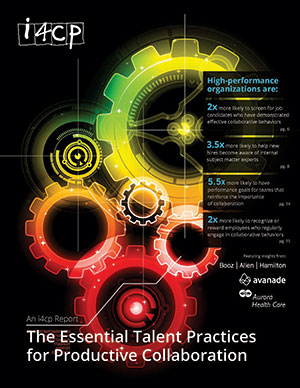Workforce Collaboration: Go from Knowing the Path to Walking the Path

Success in business today relies more and more on collaborative efforts. As outlined in the first two briefs in i4cp’s collaboration series , Purposeful Collaboration: The Essential Components of Collaborative Cultures , and The 4 Critical Traits of Collaborative Leaders , purposeful collaboration is key, and there must be focus on both culture and leadership for collaboration to flourish.
 The third brief in the four-part series,
The Essential Talent Practices for Productive Collaboration
, now available exclusively to i4cp members, delves into the touchpoints between effective collaboration and existing, core talent practices (i.e., talent acquisition, onboarding, talent development, performance management, and rewards.)
The third brief in the four-part series,
The Essential Talent Practices for Productive Collaboration
, now available exclusively to i4cp members, delves into the touchpoints between effective collaboration and existing, core talent practices (i.e., talent acquisition, onboarding, talent development, performance management, and rewards.)
The range of best and next practices that rose to the surface in the preparation of this third brief was striking. Some were focused on increasing knowledge or providing tools that enable greater collaboration, such as acquainting new hires with critical internal networks and subject matter experts, or providing training that defines what collaboration means for the organization. While the research shows these are very important, they also represent “knowing the path” towards collaboration, while other talent practices go a step further and immediately impact “walking the path.”
Training that Leverages Leaders as Teachers
Take training on collaboration-related topics for instance; the research found some topics had greater impact on market performance than others. But in terms of training methods, in addition to traditional instructor-led training and e-Learning, the use of user-generated content for learning also correlated highly with market performance. Previous i4cp research found that this can be an especially effective approach when it involves leaders as teachers.
Consider a team or unit leader who wishes to demonstrate a highly effective collaborative technique. They could lead an ILT training session to share this, but another approach would be to create a video or an audio podcast of what that effective interaction looks or sounds like and make it available on-demand for others to access when/as needed.
Sydney Finkelstein, a professor of management at the Tuck School of Business at Dartmouth College, and a speaker at i4cp’s upcoming Next Practices Now Conference, recently discussed the value of this approach in an HBR podcast interview, “Why Leaders Should Make a Habit of Teaching.” Two of the types of practices he noted were “points of craft” (specific lessons on how to do the work and run the business) and “life lessons” (e.g., how to manage your time, think about your goals).
Leaders serving as teachers can share any number of collaborative techniques, stories, etc.—authentically demonstrating how they have walked the collaborative path to optimize results. Because of their positions as respected leaders, such an approach will help drive real behavior change, increase collaboration, and generate the benefits that come from it.
Drive Collaborative Behaviors with a Map and Rewards
The most common and powerful barrier to effective collaboration is lack of incentives and rewards organizations assign to it; most talent management systems are designed to reward individual achievement.
Our research discovered several collaboration-related talent practices that correlate strongly with market performance. Surprisingly, simply having performance goals for employees, leaders, and teams that include demonstration of effective collaborative behaviors was found to be a next practice, one that is correlated to positive market performance but practiced by a relatively small number of organizations.
But beyond tweaking standard performance goals, high-performance organizations go a step further and assign stretch goals that encourage employees to seek out resources, colleagues, or solutions across business units or other boundaries. The study found high-performance organizations using this practice almost 5x more often than low-performers, and it had the strongest correlation to both market performance and collaboration effectiveness of all the HR and talent practices included in the research.
Seeding collaboration in both standard performance goals and stretch goals effectively provides an implicit map for greater collaboration, significantly increasing the chance of organic behavior change without workers even realizing it.
Finally, we all know that the right incentive can be a great motivator for behavior change. It was not surprising that recognizing or rewarding employees who regularly engage in collaborative behaviors was practiced by 2x as many high-performance organizations as low-performers. This was further confirmed in the research via a corollary: 40% of all those surveyed reported that not rewarding collaboration was one of the top barriers to increasing collaboration in their organizations, and those from lower-performing organizations were 2x more likely to report this.
Existing talent practices need to be tweaked in specific ways so that employees and leaders can and will both know and walk the collaborative path. Members of i4cp are encouraged to learn more by downloading the three briefs in this series (and watch for the fourth and final brief this spring).





